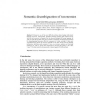850 search results - page 47 / 170 » Learning to map between ontologies on the semantic web |
OTM
2010
Springer
13 years 6 months ago
2010
Springer
Abstract. Semantic similarity aims at establishing resemblance by interpreting the meaning of the objects being compared. The Semantic Web can benefit from semantic similarity in s...
FOIS
2008
13 years 9 months ago
2008
The deployment of learning resources on the web by different experts has resulted in the accessibility of multiple viewpoints about the same topics. In this work we assume that lea...
COLING
2010
13 years 3 months ago
2010
With OWL (Web Ontology Language) established as a standard for encoding ontologies on the Semantic Web, interest has begun to focus on the task of verbalising OWL code in controll...
CCIA
2007
Springer
14 years 2 months ago
2007
Springer
Polysemy is one of the most difficult problems when dealing with natural language resources. Consequently, automated ontology learning from textual sources (such as web resources) ...
SEMWEB
2007
Springer
14 years 2 months ago
2007
Springer
In this paper we present SEMA tool for the automatic mapping of ontologies. The main purpose of SEMA is to locate one to one equivalence correspondences (mappings) between elements...

